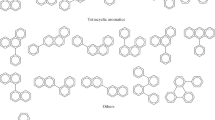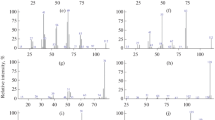Conclusions
-
1.
The hydrocarbon composition of the raw material and products of pyrolysis boiling within a wide temperature range-light oil (low boiling to 195°C), green oil (195–350°C), and hydraulic resin (270–500°C)-was investigated by the methods of molecular mass spectroscopy.
-
2.
It was shown that the initial kerosene-gas oil fraction is represented chiefly by saturated hydrocarbons (44% paraffin and 38.9% naphthene), containing from one to four rings in the molecule. Aromatic hydrocarbons are represented chiefly by alkylbenzenes (7.8%), indans, and tetralins (3.6%), and dinaphthenebenzenes (1.6%).
-
3.
It was established that the light oil of pyrolysis consists of 98% of aromatic hydrocarbons: alkyl- and alkenylbenzenes and alkylnaphthalenes. Alkylbenzenes (75.9% of the light oil) are represented chiefly by benzene and toluene; the content of alkenylbenzenes comprises 14.8 mole %.
-
4.
The structure-group composition of the green oil of pyrolysis was determined. The content of aromatic hydrocarbons of various degrees of hydrogen unsaturation, from CnH2n−6 to CnH2n−22 (90.6% on the basis of green oil), represented chiefly by naphthalene and its methyl derivatives, was determined. The content of unsaturated aliphatic hydrocarbons is low and comprises 2.7% monoolefins, 1.8% diolefins and cycloolefins, and 8.2% aromatic hydrocarbons with multiple bonds in the cycloalkyl substituent-indenes.
-
5.
The hydrocarbon composition of hydraulic resin was established. It was shown that it contains chiefly condensed hydrocarbons with two, three, and four aromatic rings: naphthalenes 35.3%, acenaphthenes 13%, phenanthrenes and anthracenes 20.2%, benzoacenaphthenes 6.1%, and pyrenes 6.6%. The resin contains 8.7% hydrocarbons with one benzene ring; alkylbenzenes, indans, and indenes.
Similar content being viewed by others
Literature cited
G. M. Badger and K. Jillian, Donnly Aust. J. Chem., No. 17, 1138–1145 (1964).
J. M. Bonner and J. Jaudemaris, Rev. del Int. Frane. de Petrole,17, Nos. 7, 8, 1016–1035 (1962).
R. G. Ismailov, G. M. Mamedaliev, and S. M. Aliev, Investigation of the Composition and Conversion of the Products of High-Temperature Decomposition of Petroleum Hydrocarbons [in Russian], Azerneshr (1968).
E. L. Matveev, A. A. Polyakova, O. I. Doshlov, and R. A. Khmel'nitskii, USSR Patent No. 204,013; Byull. Izobr., No. 21 (1967).
A. A. Polyakova and R. A. Khmel'nitskii, Introduction to the Mass Spectrometry of Organic Compounds [in Russian], Khimiya (1966).
Author information
Authors and Affiliations
Additional information
Translated from Khimiya i Tekhnologiya Topliv i Masel, No. 10, pp. 13–17, October, 1970.
Rights and permissions
About this article
Cite this article
Sosulina, L.N., Polyakova, A.A., Rabinovich, I.S. et al. Mass spectrometric investigation of the hydrocarbon composition of pyrolysis products. Chem Technol Fuels Oils 6, 735–740 (1970). https://doi.org/10.1007/BF00716433
Issue Date:
DOI: https://doi.org/10.1007/BF00716433




